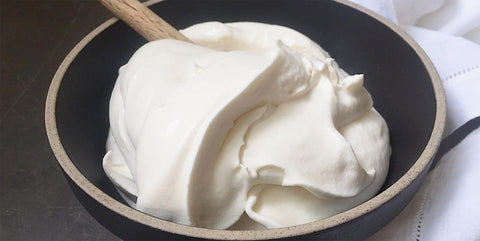Crème fraîche literally translates to "fresh cream". Sometimes called French cultured cream, this specialty food is a mild tasting dairy product that pairs perfectly with the world's best caviar selections. The light textured consistency of crème fraîche closely resembles yogurt or sour cream, but its flavor is far richer and creamier on the palate. The product itself, once used mainly as a specialty accompaniment or desert topping, is now renown for its versatile applications as a cooking ingredient. Any recipe calling for sour cream, yogurt, cream cheese, whipped cream or even mayonnaise can easily use crème fraîche as a substitute ingredient.
What does creme fraiche taste like?
Compared to its closest well-known relatives, yogurt and sour cream, crème fraîche's flavor sits somewhere in between the two. High-end crème fraîche is usually less aggressively tangy than sour cream while having more of the original sweet milky flavors often associated with good quality yogurt. It is softer and fluffier than either and only has a tinge of the sour taste that is produced from cultured creams.
Is creme fraiche healthy?
Historically, crème fraîche was created centuries ago as a method of preserving leftover milk and cream. Cultured with a small amount of lactic acid bacteria and stored at room temperature, the cream becomes a custard-like substance with an acidic environment that prevents spoilage. The cultures of this fermented product make it a good source of probiotics for healthy digestion.
While most of the nutritional values of crème fraîche are identical to cream or milk, it has a longer shelf-life and higher fat content than yogurt and sour cream. While the higher fat content might make it unhealthy to eat ever day, crème fraîche is lower in carbohydrates and usually consumed in smaller serving sizes than most other dairy products. Plus, the higher fat content does allow the product to be heated and cooked at higher temperatures without curdling.
Is creme fraiche lactose free?
Fermented dairy products, such as crème fraîche, are far lower in lactose than most non-fermented dairy products, and often easier to digest for those with a lactose intolerance. While not necessarily lactose free, cultured creams have a very low amount of the lactose sugar that can irritate the stomachs of those who do not produce enough of the enzyme lactase.
Sources:
https://www.thekitchn.com/crme-frache-what-is-it-a...



